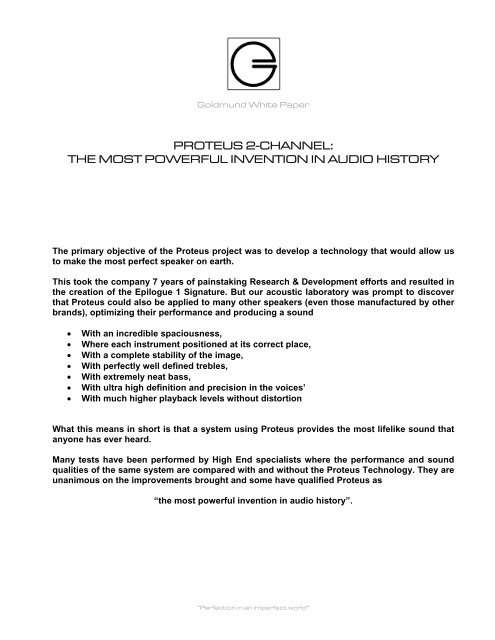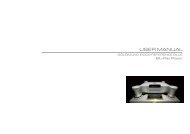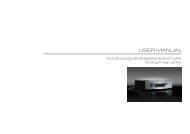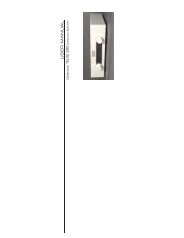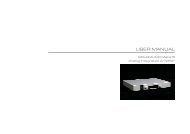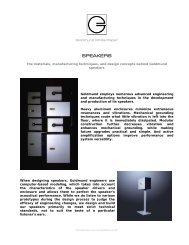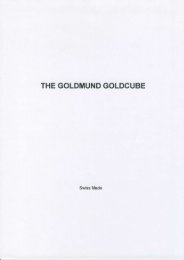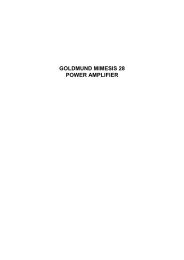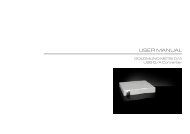Download White Paper - Goldmund
Download White Paper - Goldmund
Download White Paper - Goldmund
Create successful ePaper yourself
Turn your PDF publications into a flip-book with our unique Google optimized e-Paper software.
<strong>Goldmund</strong> <strong>White</strong> <strong>Paper</strong><br />
PROTEUS 2-CHANNEL:<br />
THE MOST POWERFUL INVENTION IN AUDIO HISTORY<br />
The primary objective of the Proteus project was to develop a technology that would allow us<br />
to make the most perfect speaker on earth.<br />
This took the company 7 years of painstaking Research & Development efforts and resulted in<br />
the creation of the Epilogue 1 Signature. But our acoustic laboratory was prompt to discover<br />
that Proteus could also be applied to many other speakers (even those manufactured by other<br />
brands), optimizing their performance and producing a sound<br />
• With an incredible spaciousness,<br />
• Where each instrument positioned at its correct place,<br />
• With a complete stability of the image,<br />
• With perfectly well defined trebles,<br />
• With extremely neat bass,<br />
• With ultra high definition and precision in the voices’<br />
• With much higher playback levels without distortion<br />
What this means in short is that a system using Proteus provides the most lifelike sound that<br />
anyone has ever heard.<br />
Many tests have been performed by High End specialists where the performance and sound<br />
qualities of the same system are compared with and without the Proteus Technology. They are<br />
unanimous on the improvements brought and some have qualified Proteus as<br />
“the most powerful invention in audio history”.<br />
“Perfection in an imperfect world”
The basic idea of the Proteus technology is to optimize a speaker’s performance by reproducing its<br />
original passive filter in the digital domain.<br />
Phase distortion, varying speaker load, and component tolerance are inherent to physical filters and<br />
affect the quality of the sound reproduction at different levels. Digital filters resolve these issues by the<br />
impossibility to be affected by material elements and by the inexistence of physical constraints.<br />
Digital filters are calculated thanks to the Proteus mathematical model that integrates all the technical<br />
parameters of the original filter and delivers digital configurations that are loaded within a <strong>Goldmund</strong><br />
Acoustic Processor (Mimesis 16, 16HD, 32 or Metis 10), in a <strong>Goldmund</strong> amplifier DSP board, or in<br />
<strong>Goldmund</strong> customized processors used in analog systems.<br />
They offer four advantages:<br />
1. They are much more precise.<br />
2. The amplifiers are directly connected to each driver (the speaker’s passive filters are<br />
bypassed) which provides a much better control over them and a better amortization.<br />
3. They allow the use of speakers at a much higher volume level without distortion.<br />
4. They also open capabilities to correct the driver much more accurately than it could be done<br />
with a passive crossover (such corrections are only made with the agreement of the speaker<br />
manufacturer).<br />
Proteus positions <strong>Goldmund</strong> as the only company in the world able to create a stereo system<br />
completely corrected in:<br />
• Amplitude<br />
• Phase<br />
• Time<br />
In audio more than any other domain, time is of the essence. A proper time alignment is crucial in<br />
what we call the Recognition Factor, which is the ability of our brain to recognize a sound as real (high<br />
recognition factor) vs. reproduced (low recognition factor). The time alignment technology used in<br />
Proteus is called the Leonardo Time Correction (see the white paper explaining Leonardo further<br />
down). In a system that does not use Proteus the listener’s brain concentrates on reconstructing the<br />
time alignment of a sound that it perceives as un-natural (time distortion does not exist in nature). In a<br />
Proteus system this action is performed by the audio system itself, leaving the brain focus on the<br />
music itself and on the true emotion that a completely natural sound brings to each passionate music<br />
listener.<br />
Today, the Proteus technology has also been extended to complete home theater system, where<br />
each driver is “managed” by Proteus but where what results of the sum of all drivers within a system is<br />
also perfectly optimized to correct the acoustic of the room itself. This is the <strong>Goldmund</strong> Media Room<br />
concept.<br />
Related web pages:<br />
<strong>Goldmund</strong> Acoustic Processors:<br />
http://www.goldmund.com/products/mimesis_32<br />
http://www.goldmund.com/products/mimesis_16hd<br />
http://www.goldmund.com/products/mimesis_16<br />
http://www.goldmund.com/products/metis_10<br />
The <strong>Goldmund</strong> Media Room:<br />
http://www.goldmund.com/media_room<br />
“Perfection in an imperfect world”
<strong>Goldmund</strong> <strong>White</strong> <strong>Paper</strong><br />
LEONARDO<br />
GROUP DELAY DISTORTION AND CORRECTION<br />
SOLUTIONS<br />
The Example of the Epilogue 1 crossover Correction<br />
Within the framework of the Leonardo project, we decided to establish whether sounds<br />
are likely to be affected by phase distortion. We will see in the next section why, in our<br />
case, we can call this kind of distortion: ”group delay distortion”. A theoretical study<br />
and appropriate listening experiments demonstrated justifiably that these effects have<br />
not to be neglected. It was decided then to analyse the group delay distortions<br />
produced by our loudspeaker systems with the aim of correcting them.<br />
“Perfection in an imperfect world”
THE EXAMPLE OF THE EPILOGUE 1 CROSSOVER CORRECTION<br />
A two-way vented loudspeaker system such as the Epilogue 1 shows three main group delay<br />
distortion sources:<br />
- the high-pass filter resulting from the medium and port alignment,<br />
- the low-pass filter resulting from the tweeter high cut-off frequency,<br />
- and the electrical internal crossover.<br />
It appeared that the most noticeable group delay distortion effect was the one produced by the<br />
electrical crossover. It was then decided to study first in detail this kind of distortion with the aim<br />
of providing a solution to correct it.<br />
The purpose of this paper is to explain our approach of group delay distortion correction,<br />
according to the concrete example of the Epilogue 1 crossover specifications.<br />
The figure below is illustrative of group delay distortion phenomenon. It shows the time<br />
modification of a half-squared signal passing through the Epilogue 1 internal crossover.<br />
It is worth noting that the amplitude frequency responses of these two signals are absolutely<br />
identical. The sole difference comes from the phase response behaviour.<br />
GROUP DELAY DISTORTION THEORY<br />
This section constitutes a summary of accepted equations defining the phenomenon of<br />
group delay distortion. Readers familiar with this material can go straight to the next<br />
section.<br />
Impulse response:<br />
Frequency response:<br />
1 ∞<br />
jwt<br />
h( t)<br />
= ∫ H ( w)<br />
e dw<br />
2π<br />
− ∞<br />
∞<br />
− jwt<br />
H ( w)<br />
=<br />
∫ h(<br />
t)<br />
e dt = H ( w)<br />
e<br />
− ∞<br />
“Perfection in an imperfect world”<br />
jϕ<br />
( w)
There are two kinds of group delay distortion:<br />
1. Minimum phase (for any |H(w)|):<br />
min<br />
If |H(w)| ≠ K (cst) ⇒ linear distortion<br />
(module)<br />
If ϕ(w) ≠ -wt ⇒ group delay<br />
distortion<br />
1 ∞ ln H ( w')<br />
( w) = ∫ dw'<br />
π<br />
− ∞<br />
w'−w<br />
ϕ (Hilbert equation)<br />
ϕ ( ) = θ ( w)<br />
− wT + θ<br />
w ap<br />
2. Phase excess: excess<br />
0<br />
with: θap(w) all-pass phase delay (~f)<br />
-wT pure delay (propagation) (~f)<br />
θ0 phase delay (not ~f)<br />
To go further into detail, we can add to our study a third phase distortion, which is not<br />
a group delay distortion, called the “phase-intercept distortion”. This distortion may<br />
happen at the initial condition t=0, even if ∆τg(w) = 0. Given that the latter is nonexistent<br />
in our case, we are authorized to use the term of “group delay distortion” as a<br />
generic term for phase distortion.<br />
In conclusion, we can say that the group delay distortion we have to correct is due to<br />
the parameters: ϕmin(w), θap(w) and θ0.<br />
As we are describing group delay distortion, it is more convenient to represent it<br />
directly from the group delay quantity:<br />
∆τ<br />
( w)<br />
− dϕ(<br />
w)<br />
− d(<br />
ϕ<br />
τ g ( w)<br />
= =<br />
dw<br />
min<br />
g<br />
( w)<br />
+ θ<br />
64<br />
44 74448<br />
ap ( w)<br />
− wT + θ 0 )<br />
= T + τ min ( w)<br />
+ τ excess ( w)<br />
dw<br />
123<br />
14243<br />
“Perfection in an imperfect world”<br />
minimum<br />
The approach we have chosen comprises correcting the group delay distortion as a whole.<br />
To simplify, we can write the group delay as:<br />
τ ( ) = T + ∆τ<br />
( w)<br />
g<br />
w g<br />
The aim of the phase correction is to add a new group delay, enabling the frequency<br />
dependent term ∆τg(w) to be compensated without modifying the amplitude response:<br />
τ<br />
( w ) = T + ∆τ<br />
( w)<br />
+ T − ∆τ<br />
( w)<br />
= T + T<br />
g<br />
g<br />
g<br />
g<br />
g<br />
excess
To illustrate the equations, the figure below shows the impulse and frequency responses of the<br />
all-pass filter simulating the group delay behaviour of the Epilogue 1 crossover.<br />
“Perfection in an imperfect world”<br />
τ ( ) = ∆τ<br />
( w)<br />
g<br />
w g<br />
As we can see, the impulse signal entering the all-pass filter (black curve) is<br />
significantly modified (red curve) in spite of a flat amplitude level. This behaviour is<br />
explained by the fact that the group delay is not constant according to the frequency.<br />
The figure below shows the response of the same all-pass filter for a delayed entering<br />
impulse signal.<br />
τ ( ) = T + ∆τ<br />
( w)<br />
g<br />
w g<br />
As we can see, the modification of the impulse signal is the same, excepted that it has<br />
been delayed in time. That means that a pure delay T corresponding to the number of<br />
delayed samples, has been added to the previous filter group delay response.
CORRECTION OF THE EPILOGUE 1 CROSSOVER GROUP DELAY DISTORTION<br />
In the case of the Epilogue 1, it is worth noting that the internal crossover has been<br />
calculated in order to obtain a flat on-axis frequency response. That means that the<br />
crossover compensates some irregularities peculiar to the medium and tweeter<br />
frequency responses. It is therefore important to correct only the group delay response<br />
of the Epilogue 1 crossover without touching its amplitude response.<br />
To do that, the first step comprises determining an all-pass filter having a group delay<br />
response corresponding to that of the Epilogue 1 crossover.<br />
We have then to calculate the behaviour in amplitude and phase of the Epilogue 1<br />
crossover. The electrical circuit below enables the crossover to be calculated according<br />
to resistive loads of 8.2 ohm.<br />
V3<br />
Rgf<br />
0<br />
R4<br />
0<br />
C1<br />
L1<br />
C6<br />
L4<br />
C3<br />
R1<br />
R2<br />
L2<br />
C7<br />
C2<br />
“Perfection in an imperfect world”<br />
L5<br />
R6<br />
R14<br />
C5<br />
C8 R13<br />
A calculation sheet has been implemented under Matlab, enabling the all-pass filter to<br />
be determined according to the Epilogue 1 crossover group delay response. The all-pass<br />
filter is determined by its resonance frequency and its group delay at this frequency.<br />
R3<br />
R5<br />
Remf<br />
8.2<br />
Retwf<br />
8.2
The figure below shows this implementation. This calculation sheet shows, for two<br />
different squared signals, the frequency and time responses of:<br />
- the Epi1 crossover amplitude (black curves)<br />
- the Epi1 crossover phase and group delay distortions (blue curves)<br />
- the all-pass filter approximating the crossover phase and group delay (red<br />
curves)<br />
- the result after group delay correction (pale blue curves)<br />
The latter comes from the multiplication of the Epi1 all-pass crossover by the inversed<br />
of the determined all-pass filter (coefficient inversion).<br />
Now, and in order to take into account the real electrical, mechanical and acoustical<br />
loads of the Epilogue 1 system, it is important to readjust the all-pass filter according to<br />
the equivalent electrical circuit illustrated below.<br />
“Perfection in an imperfect world”
Rgf<br />
V3<br />
0<br />
R4<br />
C1<br />
L1<br />
0<br />
C6<br />
C3<br />
R1<br />
R2<br />
L4<br />
L2<br />
C7<br />
C2<br />
R6<br />
C5<br />
Letwf<br />
Htwf<br />
+ -<br />
Bl<br />
mmsmf<br />
R14 mmstwf Rmstwf<br />
L5<br />
R3<br />
C8<br />
R5<br />
R13<br />
Remf<br />
Retwf<br />
Lemf<br />
Hf<br />
+ -<br />
Bl<br />
Hfb<br />
-Bl<br />
+<br />
-<br />
Htwfb<br />
-Bl<br />
+<br />
-<br />
Rmsmf<br />
“Perfection in an imperfect world”<br />
0<br />
Cmsmf<br />
Cmstwf<br />
Ef<br />
+<br />
-<br />
Sd<br />
Etwf<br />
+<br />
-<br />
Sd<br />
+<br />
-<br />
+<br />
-<br />
Ff<br />
-Sd<br />
0 0<br />
Ftwf<br />
-Sd<br />
marf<br />
Cabf<br />
martwf<br />
0<br />
Rapf<br />
mapf
As explained above, the correction of the Epilogue 1 group delay distortion comes from<br />
the multiplication of its all-pass crossover by the inverse of the chosen all-pass filter<br />
(coefficient inversion).<br />
In the case of IIR filters (chosen for their coefficient number), the transfer function of<br />
the determined all-pass filter may be written as:<br />
M<br />
∑<br />
bm<br />
z<br />
m=<br />
0<br />
H ( z)<br />
= N<br />
a z<br />
The correction filter will be written simply by inverting the coefficients:<br />
H<br />
−1<br />
∑<br />
n=<br />
0<br />
∑<br />
∑<br />
m=<br />
0<br />
−m<br />
−n<br />
“Perfection in an imperfect world”<br />
N<br />
n<br />
an<br />
z<br />
n=<br />
0<br />
( z)<br />
= M<br />
b z<br />
The figure below shows the frequency responses (amplitude, phase and group delay) of<br />
H(z) in magenta and 1/H(z) in red.<br />
m<br />
−n<br />
−m
As we can see, the result of the summation of group delays is equal to zero. The group<br />
delay distortion has then been properly corrected.<br />
This filter, however, cannot be implemented as it is, due to its non-causal behaviour.<br />
This property is demonstrated by the negative group delay curve, meaning that the<br />
correction filter 1/H(z) responds before it receives its triggering signal, which is<br />
obviously not possible.<br />
Moreover, the figure below shows that the all-pass correction filter is also unstable. It<br />
is illustrated by the fact that its poles are outside the unity circle, meaning that its<br />
impulse response goes toward infinity (red curve).<br />
In conclusion, we can say that our IIR correction all-pass filter is non-causal and<br />
unstable.<br />
If it is possible to render it causal by introducing a delay before its transfer function, it<br />
is impossible to render it stable without touching its amplitude and degrading its phase<br />
response.<br />
The solution to this significant problem is provided by the time reversal method.<br />
“Perfection in an imperfect world”
TIME REVERSAL METHOD<br />
The purpose here is not to explain this method in detail. People interested in analysing<br />
this in greater depth can consult us.<br />
This solution offers the advantage of calculating the IIR filter H(z) instead of its noncausal<br />
and unstable inverse. The inversion is carried out by inversing the samples<br />
before and after the filter H(z).<br />
The complete method has been implemented under Simulink and Matlab in order to<br />
verify the theory with the view of a DSP implementation. The figure below shows the<br />
Simulink block diagram implementation.<br />
signal.wav<br />
signal<br />
up<br />
z -50<br />
down<br />
z -50<br />
In1 Out1<br />
Phase EPI1<br />
clr_up<br />
In<br />
Push<br />
Stack Out<br />
Pop<br />
Clr<br />
clr_down<br />
In<br />
Push<br />
Pop<br />
Clr<br />
Stack Out<br />
num1<br />
num2<br />
X_filt.wav<br />
sig_filt<br />
xr_inv<br />
xr1_inv<br />
Rst<br />
50<br />
Rst 50<br />
xr2_inv<br />
rst_up<br />
In1 Out1<br />
Phase EPI1 (up)<br />
rst_down<br />
In1 Out1<br />
Phase EPI1 (down)<br />
yyr1_filtre<br />
z -50<br />
yyr2_filtre<br />
Rst 50<br />
Rst 50<br />
“Perfection in an imperfect world”<br />
yr1_filtre0<br />
z -100<br />
yr1_filtre<br />
yr2_filtre<br />
yr<br />
Y_inv.wav<br />
In1 Out1<br />
Phase EPI1 (v)<br />
In<br />
Push<br />
Pop<br />
Clr<br />
Stack Out<br />
In<br />
Push<br />
Pop<br />
Clr<br />
Stack Out<br />
Y_correct.wav<br />
The input signal is acquired in consecutive sections of the length L samples.<br />
The sections are time reversed (input LIFO buffers) and separated in two signals (the<br />
sections are taken half the time and completed by zeros to form sections of the length<br />
2L samples).<br />
Both signals are filtered by identical causal and stable IIR all-pass filters, which are<br />
initialised at each double section beginning.<br />
Both filtered signals are recombined in leading and trailing sections. The leading<br />
sections signal is delayed of 2L samples. Both resulting signals are adding together.<br />
The sections are again time reversed (output LIFO buffers).<br />
y_corr<br />
y
The figure below show the curves (calculated under Matlab) related to the different<br />
block outputs.<br />
The yellow curve gives the response of the Epilogue 1 crossover excited by the<br />
superposed red input signal.<br />
After time reversal computation, the correction all-pass filter is given by the blue curve.<br />
In order to verify the group delay correction made by this filter, all we have to do is to<br />
cascade the all-pass correction filter (blue) and the all-pass crossover (yellow).<br />
The result is given by the last red curve. As we can see, this curve shows a very high<br />
degree of accuracy compared to the excitation signal. The small 4L delay comes from<br />
the implementation buffers. These calculations validate the time reversal method.<br />
“Perfection in an imperfect world”
The method has been then programmed in DSP following the block diagram below.<br />
input<br />
in_inv buffer out_inv output ( delay = 4L)<br />
0<br />
0<br />
0<br />
F1<br />
F2 reset<br />
0<br />
F1 reset<br />
F2 reset<br />
0<br />
F1 reset<br />
F2 reset<br />
0<br />
F2<br />
F2<br />
F2<br />
F1<br />
F1<br />
F1<br />
“Perfection in an imperfect world”
The figure below shows the DSP computed response of the correction all-pass filter (in<br />
blue) for a step excitation (in red).<br />
As we can see, the blue curve fits well with the one calculated previously during the<br />
method validation step.<br />
This result concludes with success the first stage of the Leonardo project. We have<br />
carried out some preliminary demo listening tests and we can say that the results are<br />
extremely impressive...<br />
REFERENCES<br />
S.A. Azizi. Realization of linear phase sound processing filters using zero phase IIR<br />
filters. AES preprint 4506, March 1997.<br />
D. Koya. Aural phase distortion detection. Thesis submitted to the University of Miami,<br />
May 2000.<br />
S.R. Powell and P. M. Chau. A technique for Realizing Linear Phase IIR Filters. IEEE<br />
Transactions on signal processing, 39(11): 2425-2435, November 1991.<br />
“Perfection in an imperfect world”


